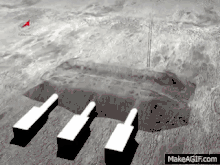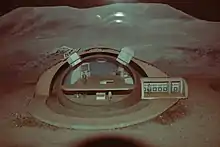Moonbase
A moonbase is a permanent infrastructure sustaining human operations at the Moon.

There are several missions by different agencies and companies planned to establish a longterm human presence on the Moon, with the orbital Lunar Gateway as the currently most advanced project as part of the Artemis program.
Proposals
NASA
The United States space administration NASA has requested an increase in the 2020 budget of $1.6 billion, in order to make another crewed mission to the Moon by 2024, followed by a sustained presence on the Moon by 2028. NASA is ready to announce plans to bring together a Commercial Human Lander Awards for Artemis Missions on the Moon. This specific program, “The Artemis Program,” encompasses NASA’s overview for lunar exploration plans. This announcement will go over the first in a series of many more to come complex missions. Artemis I will start off as an un-crewed flight test to demonstrate the capabilities of NASA’s Space Launch System (SLS) rocket and Orion spacecraft. The first flight with a crew will be Artemis II, closely followed by Artemis III that will actually land crew on the moon by the end of 2024 using a new commercially-procured Human Landing System (HLS). They hope to develop a sustainable lunar exploration program starting from 2028.[1]
Project Horizon
Project Horizon was a 1959 study regarding the United States Army's plan to establish a fort on the Moon by 1967.[2] Heinz-Hermann Koelle, a German rocket engineer of the Army Ballistic Missile Agency (ABMA) led the Project Horizon study. It was proposed that the first landing would be carried out by two "soldier-astronauts" in 1965 and that more construction workers would soon follow. It was posited that through numerous launches (61 Saturn Is and 88 Saturn C-2s), 245 tons of cargo could be transported to the outpost by 1966.
Lunex Project
Lunex Project was a US Air Force plan for a crewed lunar landing prior to the Apollo Program in 1961. It envisaged a 21-person underground Air Force base on the Moon by 1968 at a total cost of $7.5 billion.
Sub-surface base
In 1962, John DeNike and Stanley Zahn published their idea of a sub-surface base located at the Sea of Tranquility.[3] This base would house a crew of 21, in modules placed four meters below the surface, which was believed to provide radiation shielding on par with Earth's atmosphere. DeNike and Zahn favored nuclear reactors for energy production, because they were more efficient than solar panels, and would also overcome the problems with the long lunar nights. For the life support system, an algae-based gas exchanger was proposed.
Zvezda

Zvezda moonbase (Russian: звезда, "star") was a Soviet plan and project from 1962 to 1974 to construct a crewed moonbase as successor to the N1-L3 crewed lunar expedition program. The project was ordered by the Soviet space chief Korolyov to Barmin's Spetcmash bureau. The project was named DLB Lunar Base in technical specifications and Zvezda in government documents. Unofficially, the project was called Barmingrad (Barmin's city) by its designers.
The realization of the project depended on key parts of the N1-L3 program – the N-1 superheavy launcher, all 4 launches of which failed between 1969 and 1972. Zvezda moonbase was canceled with the rest of the Soviet human lunar programs. All crewed Soviet lunar programs, including a Zvezda moonbase, had been classified as top secret and were only published in the glasnost epoch since 1990.
Moon Village

The Moon Village (fr) concept was presented in 2015.[5] 'Village' in this context refers to international public and private investors, scientists, engineers, universities, and businessmen coming together to discuss interests and capabilities to build and share infrastructure on the Moon and in cislunar space for a variety of purposes. It is neither an ESA project nor a program, but being organized, loosely, by a nonprofit organization seeking to give a platform for an open international architecture and collaboration. In other words, Moon Village seeks to create a vision where both international cooperation and the commercialization of space can thrive.[6][7][8]
- "The Moon Village is not one project or one program. It says, 'Let's do it together.'" | Jan Wörner[9]
The open nature of the concept would encompass any kind of lunar activities, whether robotic or astronauts, 3D printed habitats,[10] refueling stations, relay orbiters, astronomy, exploiting resources, or even tourism. The idea is to achieve at least some degree of coordination and exploitation of potential synergies and to create a permanent sustainable presence on the surface of the Moon, whether robotic or crewed.[6][7] Jan Wörner, ESA Director General, describes the Village simply as "an understanding, not a single facility".[11] This initiative is meant as the first step in coming together as a species and develop the partnerships and "know how" before attempting to do the same on Mars.[6][12] The Director General of ESA, Jan Wörner, states that this vision of synergy can be as inspiring as the International Space Station but on a truly global, international-cooperation basis, and he proposes this approach as a replacement for the orbiting International Space Station, which is due to be decommissioned in 2024.[12][13]
China has expressed interest,[14][15] and NASA has also expressed interest in the potential synergy it offers to the proposed Lunar Gateway.[8][16] The private aerospace company Blue Origin has also expressed early interest and offered to develop a cargo lander with a 4,500 kg (9,900 lb) capacity of usable payload.[17] Astronaut Buzz Aldrin has long urged his fellow Americans to cooperate with international partners to reach the Moon.[18] The State Space Agency of Ukraine has agreed to uphold MVA principles and cooperate with the MVA to develop "sustainable habitation" of the Moon. [19]
While Woerner is the most famous advocate for Moon Village, it is not an ESA program. Instead, the concept is being organized, loosely, by a nonprofit organization established in November 2017 called the Moon Village Association.[20][21] It is a non-profit organization, registered in Vienna, with the mission to create a global forum for the development of the Moon Village, and to potentially implement a permanent human settlement near the lunar south pole, taking advantage of near-continuous sunlight and nearby deposits of ice and other useful volatiles.[20]
International Lunar Research Station (ILRS)
China has proposed in 2020 the International Lunar Research Station (ILRS), a somewhat similar proposal to the Moon Village, with Roscosmos and ESA showing interest.[22]
Other proposals
In 2007, Jim Burke, of the International Space University in France, said people should plan to preserve humanity's culture in the event of a civilization-stopping asteroid impact with Earth. A Lunar Noah's Ark was proposed.[23] Subsequent planning may be taken up by the International Lunar Exploration Working Group (ILEWG).[24][25][26]
References
- "America to the Moon by 2024 – NASA's FY 2020 Budget Amendment Summary" (PDF). NASA. Retrieved 2019-05-17.
- Dept. of the Army, Project Horizon, A U.S. Army Study for the Establishment of a Lunar Military Outpost, I, Summary (Redstone Arsenal, AL, 8 June 1959). See also: Moonport: A History of Apollo Launch Facilities and Operations
- "Lunar Base Designs". Aerospace Scholars. 17 March 2008. Archived from the original on 2008-06-11. Retrieved 2009-09-12.
- Телестудия Роскосмоса (2009-05-12), Лунный Барминград. Lunar Barmin-City., retrieved 2016-02-23
- Should we build a village on the Moon? Richard Hollingham, BBC News. 1 July 2015.
- Moon Village: A vision for global cooperation and Space 4.0 Jan Wörner, ESA Director General. April 2016.
- . Leonard David, Space.com. 26 April 2016.
- Moon Village: humans and robots together on the Moon. ESA. 1 March 2016.
- Urban planning for the Moon Village. Jeff Foust, Space News. 26 December 2018.
- ESA Vision and lunar 3D printing Tests. ESA . 15 January 2013.
- ESA Moon Village – what it really is? Marcin Wolny, Tech For Space. 11 May 2017.
- Moon village the first stop to Mars: ESA. PhysOrg. 28 September 2018.
- ESA's Plan for a "Moon Village" is Slowly Starting to Come Together. Cecille De Jesus, Futurism. 8 January 2017.
- China and Europe May Build A "Moon Village" in the 2020s. Universe Today. 30 April 2017.
- ‘Moon Village’ could be a thriving colony of 1,000 by 2050. Colm Gorey , Silicon Republic. 25 September 2017.
- The Global Exploration Roadmap. (PDF) International Space Exploration Coordination Group. NASA. January 2018.
- Foust, Jeff (29 May 2018). "Bezos outlines vision of Blue Origin's lunar future". SpaceNews. Retrieved 21 August 2018.
- Aldrin, Buzz (2013). Mission to Mars: My Vision for Space Exploration. With Leonard David. National Geographic Society. p. 18. ISBN 9781426210174.
- URL = https://moonvillageassociation.org/press-release-ukraine-has-joined-the-moon-village-association/ | accessdate = 2020-08-10
- Burke, John D (25 January 2018). "International meetings: Moon initiatives International meetings: Moon initiatives". The Planetary Society Blog. The Planetary Society. Retrieved 2018-01-28.
- "Moon Village Association". Moon Village Association. Retrieved 2018-01-28.
- Andrew Jones (21 August 2020). "China is aiming to attract partners for an international lunar research station". Retrieved 30 November 2020.
- "'Lunar Ark' Proposed in Case of Deadly Impact on Earth". nationalgeographic.com. Retrieved 12 June 2015.
- Chittenden, Maurice (9 March 2008). "Mankind's secrets kept in lunar ark". The Sunday Times. London. Retrieved 2008-03-16.
- Highfield, Roger (10 March 2008). "Plans for 'doomsday ark' on the moon". Telegraph.co.uk. London. Archived from the original on 2008-03-14. Retrieved 2008-03-16.
- Platt, Kevin Holden (14 August 2007). "'Lunar Ark' Proposed in Case of Deadly Impact on Earth". National Geographic News. Retrieved 2008-03-16.